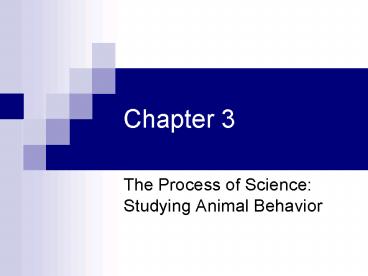The Process of Science: Studying Animal Behavior - PowerPoint PPT Presentation
1 / 30
Title: The Process of Science: Studying Animal Behavior
1
Chapter 3
- The Process of Science Studying Animal Behavior
2
Concept 3.1
- Biologists study through observations and
experiments - Key Terms
- Animal Behavior
- Immediate Cause
- Ultimate Cause
3
Asking Questions about Animal Behavior
- Why do whales make bubble nets?
4
Observing Behavior in Natural Environments
- Jane Goodall observed chimpanzees in their
natural habitat
5
Designing Experiments on Animal Behavior
- Niko Tinbergen
- Digger Wasp
6
Immediate and Ultimate Causes of Behavior
- Immediate Cause
- Immediate interactions with the environment
- Explains How?
- Ultimate Cause
- Explanations based on evolutionary
characteristics - Explains Why?
7
Concept 3.2
- Experiments show that both genes and environment
affect behavior. - Key Terms
- Innate behavior
- Fixed action pattern
- Circadian rhythm
8
Nature vs. Nurture
- Behavior is due to genes (NATURE) or environment
(NURTURE)
9
Innate Behaviors
- Behavior performed correctly by all individuals
of a species, even if they have no prior
experience. - Nest Building
- Web Weaving
- Suckling
10
(No Transcript)
11
Fixed Action Pattern
- Greylag Goose
- Egg Rolling
- Yawning
12
Rhythms of Behavior
- Circadian Rhythm
- Biological clocks
- Jet Lag
- Migration
13
(No Transcript)
14
Concept 3.3
- Learning is behavior based on experience.
- Key Terms
- Learning
- Habituation
- Imprinting
- Conditioning
- Insight
15
Learning vs. Habituation
- Learning
- Change in animals behavior resulting from
experience - Habituation
- Animals learn NOT to respond to stimulus
- Hydra to touch
- Humans ticking clocks, jewelry, etc
- Scarecrows
16
Benefits to Habituation?
- Animals do not waste time or energy on less
important stimuli and instead focus on food,
mates, or real danger
17
Imprinting
- Limited to a specific time frame
- Critical learning period
- Often results in a strong bond between 2
organisms - Konrad Lorenz
18
Conditioning
- Learning that a specific stimulus/response is
linked to a reward/punishment - Classical Conditioning
- Operant Conditioning
19
Classical Conditioning
- Otherwise associated with meaningless behavior
- Pavlovs Dogs
20
Operant Conditioning
- Trial-and-Error Learning
- Animals learn that their behavior have a positive
or negative effect
21
Insight
- Animals are able to respond to a new situation
WITHOUT previous experience - Ability to analyze problems and test solutions
- Octopus Jar
- Chimp Boxes Banana
22
Play Behavior
- Practice Hypothesis
- Animals practice behaviors that are required for
survival - Exercise Hypothesis
- Play helps keep the animals cardiovascular and
muscular systems in top condition
23
Concept 3.4
- Social behaviors are important adaptations in
many species. - Key Terms
- Aggressive behavior
- Dominance heirarchy
- Territory
- Courtship ritual
- Communication
- Cooperation
24
Competitive Behaviors
- Animals sometimes live in social groups that
compete for food, space, and mates - Aggressive Behavior
- Dominance Hierarchies
- Territorial Behavior
25
Aggressive Behavior
- Actual physical struggles
- Tests of strength (or the more determined)
- In most cases one individual stops threatening
and submits to the other
26
Dominance Hierarchies
- Ranking from the most aggressive to least
aggressive animal in the group - Each animal has a specific location on the
pecking order that way they dont waste energy
fighting and instead have specific jobs based on
their role in the group
27
Territorial Behavior
- Animals establish specific territories for
themselves and protect it from other members of
the same species - Fighting
- Scents
- Sounds
- Territories are used for breeding sites, places
to raise young, as well as access to the best
food sites
28
Courtship Behavior
- Elaborate rituals before mating to attract the
best mate
29
Communication
- Different animals use a variety of ways to
communicate within their species - Sounds
- Odors
- Visual displays
- Touching
30
Cooperation
- Individuals work together in a way that is most
beneficial to the group - Packs of Wolves
- Musk Oxen































